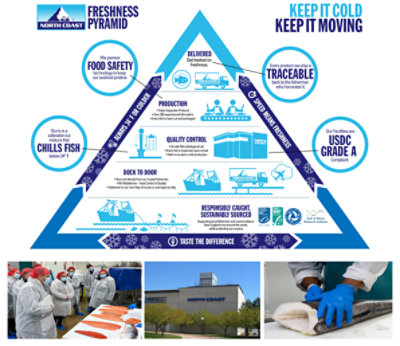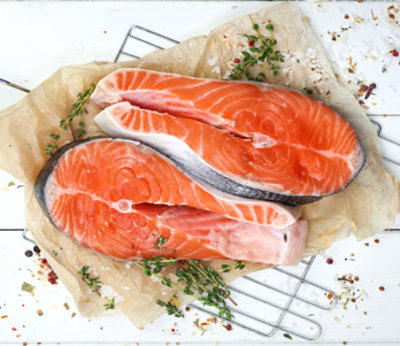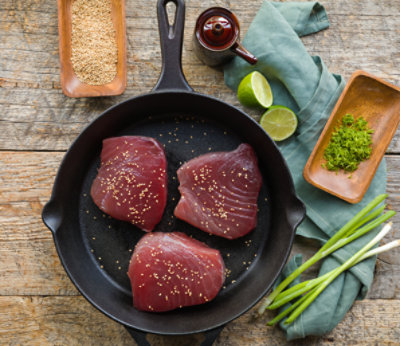Welcome back!
You're currently shopping with your default address:
Norwegian people and culture are shaped by a place on the harsh edge of the world. Cold air and deep coastal waters make for a way of life that Norway has shared and relied on for centuries. Fish grow slowly in these ice-cold waters yielding incredibly firm flesh, unsurpassed in taste, color and texture. Through innovation, grit and determination, the people of Norway sustainably produce and harvest this delicious cold-water bounty to share with the world.
• Seafood thrives in Norway’s natural environment – no other place on Earth comes close to replicating these harsh yet ideal conditions
• Norway’s climate and environment (extreme cold, a vast coastline) are harsh but are the perfect conditions for the best seafood. Icy, clean waters allow fish to grow slowly, leading to unsurpassed flavor.
• Norwegian aquaculture standards are the most rigorous in the world. Thoughtful care for ocean health ensure Norway’s seafood industry is a world leader in responsible farming and harvesting practices as well as wild resource management, fishing, processing and distribution.
• Norwegian salmon is antibiotic-free and non-GMO, raised in a ratio of 97.5% water to 2.5% fish.
• From the health of our individual bodies to the health of our planet, Seafood from Norway is one of the world’s best sources of nourishment.
• Seafood from Norway is the perfect addition to a balanced and healthy lifestyle. The Dietary Guidelines for Americans and the American Heart Association recommend adults eat at least or 2-3 servings, or 8 ounces of seafood per week based on a 2,000 calorie diet.
• Fatty fish, such as salmon, Norway’s primary export to the U.S., is a good source of heart healthy omega-3 fatty acids.

At Shaw’s, our Seafood Experts have gone through hours of in-depth training and education, led by our partners at North Coast Seafoods, to ensure we’re providing our customers with the best seafood experience possible.
Founded in 1957, North Coast is a family-owned, Boston-based, quality-obsessed Seafood company committed to providing our customers with a consistent supply of the finest quality, sustainable fish, and shellfish imaginable from local communities around the globe.
North Coast is a direct-importer and first receiver, which means they cut out the middleman by partnering directly with our trusted, dedicated, veteran fishermen to source the absolute highest caliber seafood – the “top of the catch”.
From there, they cut and process the seafood in their own state of the art USDC Grade A Compliant facilities and distribute it directly to their retail partners, like Shaw’s.
Their deeply anchored relationships and decades of experience allow them to maintain complete control of quality from Shore to Store, so you can be confident that the seafood you purchase at Shaw’s is the freshest, best tasting seafood available.
North Coast is authentic, uncompromising, dependable, accountable, and innovative in their mission of sharing the joy of extraordinary seafood.
At North Coast Seafoods, sustainability isn’t just a buzzword, it’s a practice they live by day in and day out. As a company that depends on our oceans’ natural resources, they are keenly aware of their responsibility to source and promote sustainable seafood.
Simply put – Sustainable Seafood means seafood that is caught, farmed, or harvested using environmentally harmonious and socially responsible methods that jeopardize neither the health of our oceans nor the stability of the species in question.
North Coast is proud to work with several local and international sustainability organizations – such as the Best Aquaculture Practices, Aquaculture Stewardship Council and Marine Stewardship Council – to ensure that the seafood that they handle is environmentally responsible and remains plentiful for future generations to enjoy.
Sustainable Seafood is a story of continuous improvement, rather than a final destination to be reached. As part of the global seafood community, North Coast Seafoods regularly evaluates their impact and looks for new ways to make further improvements to overall sustainability.
Local Seafood is ingrained in the history and culture of Massachusetts and New England as a whole. Buying Gulf of Maine seafood means supporting the livelihoods of local New England fishermen.
North Coast is proud to continuously support our local fishing community by purchasing fresh Gulf of Maine seafood from the historic Boston Fish Pier, just 5 minutes down the road from their headquarters, and the Port of New Bedford.
Some of these species include Atlantic: Pollock, Acadian Redfish (Ocean Perch), Sea Scallops, Monkfish, Haddock, Hake, Whiting, and Winter Skate.
Learn more about North Coast Seafoods here.
Because wild salmon has a lower fat content, bake at a lower temperature for a longer period of time to maintain its natural juiciness.
For example – try baking wild salmon at 275°F for 25-28 minutes.
Use a neutral oil with a high smoke point (not extra virgin olive oil).
Like canola oil, sunflower oil, avocado oil, peanut oil, etc.
Be sure that you allow your oil to get hot enough. Your seafood should sizzle when placed in the pan. If it doesn’t, allow oil to heat for a minute more and try again.
Once the seafood is in the pan, try not to move it until you’re ready to flip. This will allow a beautiful layer of caramelization to form on your salmon.
Check for doneness by gently pushing the flat side of a wooden skewer through the thickest part of the fish. If it goes through with no resistance, it is done. If there is resistance, cook for another minute or so and test again.
If you are testing for internal temperature – 145°F is good.


Both Wild Caught and Farmed seafood can be high-quality, sustainable, and delicious choices. And both are essential to ensuring continued seafood availability for future generations.
It is important to remember that just like farm-raised chicken - there are good farms and bad farms. North Coast Seafoods is committed to sourcing only from Certified Sustainable operations.
Most ocean fish contain negligible amounts of Mercury in comparison with Selenium, which is the mineral needed for our brain and nervous system to function.
Ocean fish also have far higher levels of Selenium, which counteracts risks of mercury toxicity by binding with the element, neutralizing any potentially harmful effects.
Certain wild predatory species of larger fish such as Tilefish, Swordfish and Shark do contain higher levels of mercury. However, you would need to eat these species several times a week to be at risk.
Yes, and they are encouraged to do so as part of a healthy balanced diet!
Studies have actually shown that children gain an average of 7.7 full IQ points when their moms ate seafood during pregnancy compared to moms that did not eat seafood.
Recommended to avoid the few fish that have comparatively higher levels in mercury: King Mackerel, Marlin, Orange Roughy, Shark, Swordfish, Tilefish from the Gulf of Mexico, and Bigeye Tuna (usually only found in sushi).
Children are absolutely encouraged to eat seafood. The nutrition that a proper seafood diet provides is influential in a child's physical and developmental health, the FDA and EPA support.
The nutrients, vitamins, and minerals found in seafood are incredibly helpful during childhood development. Omega-3s are crucial for proper brain development and decrease the risk of developmental disorders in babies and adults. There is also strong evidence to show seafood can improve focus + grades in school, reduce anxiety + ADHD symptoms, and help kids sleep better.
Both wild and farmed seafood can be sustainable. With seafood consumption rising worldwide, well-managed ocean-raised (farmed) fish can take pressure off wild fish populations + fisheries, where 90% of wild stocks are harvested at full capacity.
For Wild Caught Seafood, sustainability means the populations are well-managed and not overfished, and the fishing method has minimal impact on habitat and other wildlife (limiting bycatch and minimizing damage to marine habitats).
Also, Research has shown that seafood is the most carbon-efficient source of protein on the planet. Seafood requires no land or additional water resources to harvest and even has a lower impact on wildlife compared to land-based proteins. Compared to protein sources harvested on land, seafood production produces much fewer greenhouse gas emissions and less freshwater pollution.